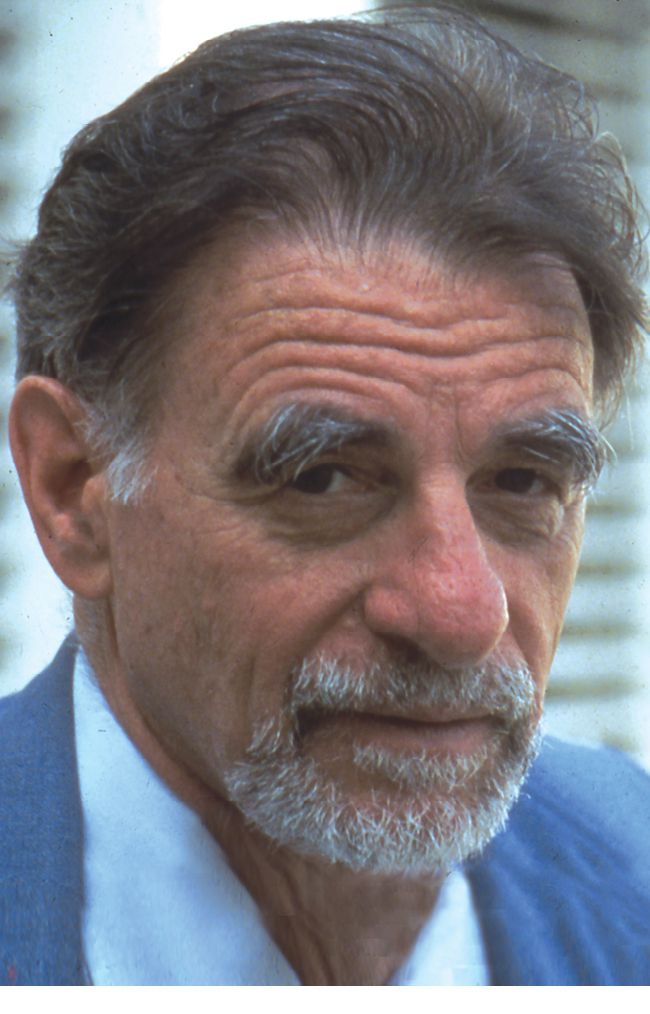Karl Alexander Müller
DOI: 10.1063/PT.3.5241
Karl Alexander Müller, synonymous with his pioneering work in structural phase transformations, ferroelectricity, and superconductivity in oxides, peacefully passed away on 9 January 2023 in Zollikerberg, Switzerland. He was an IBM fellow, a professor of physics at the University of Zurich, and a corecipient of the 1987 Nobel Prize in Physics.

Karl Alexander Müller
AIP ESVA/W. F. MEGGERS GALLERY OF NOBEL LAUREATES COLLECTION

Alex was born on 20 April 1927 in Basel, Switzerland. After the early death of his mother, he attended a boarding school in Schiers in the Swiss Alps, where he became an enthusiastic radio hobbyist and skier. He studied physics at ETH Zürich. There Alex was strongly influenced by Wolfgang Pauli and his lectures and developed a lifelong admiration for him.
For his PhD thesis, Alex built an apparatus for measuring the resonance of paramagnetic impurities in crystals and determined the resonance of the iron-doped single-crystal strontium titanate (STO). That work became a true landmark in Alex’s scientific life. With the first detection of a structural phase transition in STO from cubic to tetragonal around 100 K, he established electron paramagnetic resonance (EPR) as an important local tool for studying impurities in solids.
STO served as a model substance for many perovskites, but for Alex, the beauty and simplicity of the crystal structure became his mandala—a spiritual, empowering, and inspiring symbol.
After getting his PhD, Alex started in 1959 at the Battelle Memorial Institute in Geneva as head of the magnetic resonance group. In view of his scientific reputation, the IBM Zurich Research Laboratory in Rüschlikon offered him the position of a research staff member in 1963, and eight years later he was promoted to lead the physics department. His focus was on STO and related perovskites regarding their dielectric, polar, and structural properties. He received the most attention for his discovery of quantum paraelectricity, where the polar instability in STO is suppressed by quantum fluctuations.
Alex’s early interest in the Jahn–Teller (JT) effect became important for the later search for superconductivity in oxides. Using EPR, he demonstrated both the static and the dynamic JT effect of impurities with orbitally degenerate ground states in perovskites. A decisive step happened in 1978 when Alex left the IBM Zurich lab for a sabbatical at the IBM Thomas J. Watson Research Center in Yorktown Heights, New York. As an IBM fellow, he had the freedom to decide independently about his further research areas. For the first time, he became intensely involved in superconductivity—another milestone on the way to the Nobel Prize.
Back in Zurich, Alex, inspired by the prediction of Harry Thomas of the existence of JT polarons in semiconductors, considered the importance of oxides for superconductivity and applied the concept to conducting oxides with JT centers. Alex asked one of us (J. Georg Bednorz) to join him in the project and was, as he later confessed, very surprised by the spontaneous acceptance. Georg had previously worked with Gerd Binnig on superconductivity in STO and was disappointed that Gerd ended the project in 1982.
Indeed, that was a venturous enterprise with an uncertain outcome—but it took only three years to achieve the breakthrough in 1986 with the discovery of the lanthanum barium copper oxide, or La‑Ba‑Cu‑O, system. At the 1987 American Physical Society March Meeting—later called the Woodstock of Physics—in New York, the discovery was already peaking tremendous interest and was being covered by the New York Times. Both Georg and Alex were awarded the Nobel Prize in Physics in October of that year for their discovery of superconductivity in ceramic materials.
In the following years, Alex continued his activities in superconductivity to demonstrate that the JT polarons were the source of the electron pairing in oxides, when the generally believed assumption was that the source was of a purely electronic origin. The ceramic character of those oxides strongly supported his conviction that inhomogeneity is essential to high-temperature superconductivity, and he questioned the assumption that the pair wavefunction has a d-wave order parameter. Instead, Alex postulated that two order parameters, s + d, are necessary to understand experiments that are incompatible with a single d-wave order parameter. To demonstrate the importance of the lattice for the pairing mechanism, he initiated a project on isotope effects. Numerous unexpected isotope effects on characteristic superconducting properties were discovered, which supported Alex’s idea of the JT polarons and unconventionally strong local electron–lattice interactions as the driving force for high-temperature superconductivity.
Alex was an inspiring teacher who encouraged young scientists to follow their own ideas in research. He participated regularly in university life and frequently attended seminars at the physics institute of the University of Zurich. In his private life, Alex was a devoted husband, father, and grandfather who shared not only his musical interests but also many travel memories with his wife, Ingeborg.
We will deeply miss him, not only as an ingenious scientist but also as a great friend who always supported us both in scientific endeavors and with respect to our private welfare.
More about the Authors
J. Georg Bednorz. IBM Research, Rüschlikon, Switzerland.
Annette Bussmann-Holder. Max Planck Institute for Solid State Research, Stuttgart, Germany.
Hugo Keller. University of Zurich, Zurich, Switzerland.
